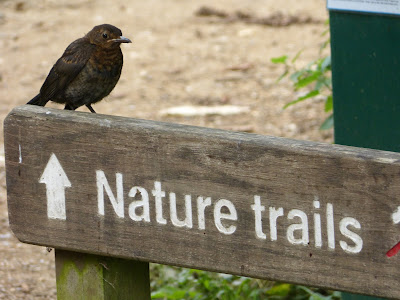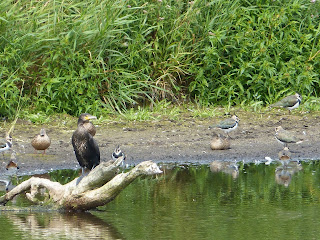Aware of time and the fact that we would need to cycle home after our visit, we didn't complete a full circuit, but instead followed the Fen trail to Fen hide, Tower hide, then returned along the same route back to reception.
Stopping at the pond dipping station not far from the reception, common darters alighted regularly on the wooden fence. In the process of trying to photograph one, a fly took my camera's focus instead, resulting in the image below. Eventually, an opportunity presented itself to photograph an un-obscured common darter dragonfly. The other dragonflies we saw were too fast for me to photograph, but included brown hawkers, emperors and black-tailed skimmers.
The usual birds of the reserve were remarkably quiet, but the butterflies were out in force. On the short trail to Fen hide, a painted lady landed, sunning itself on the dry mud of the 'path'. Except for the individuals I have raised and released with my classes at school, I had not seen a painted lady in the UK before.
There were three stars of the show in Fen hide. From speaking to other visitors, we had just missed a kingfisher, but we had other avian species to occupy us. A young marsh harrier had claimed a spot in a small tree not far from the hide. After a few minutes of waiting and watching, a black swan gracefully swam into view, preening itself in the shallow water. A bittern also appeared a way back, lightly skimming over the reeds before descending and vanishing again.
We lingered by the buddleia where, on our last visit, we saw a swallowtail butterfly. No swallowtails today, despite hearing news of the second brood being on the wing, but plenty of other butterflies taking the limelight and looking glorious in the sunshine. The brimstones and red admirals looked particularly impressive today, with the sun back lighting their delicate forms.
Before we even reached Tower hide we could hear the lovely, incessant calling of a desert of lapwings. Entering the hide painted a more detailed scene; intermingled with the sea of purpley-green lapwings were orange-beaked ruffs, a single common tern, a royal looking cormorant on a throne of driftwood, bright white little egrets, statuesque grey herons and snow white mute swans. Above them all were dancing marsh harriers silhouetted against the bright sky. There was also a sleeping wader which has proved a bit of a mystery to identify. I think it may be a ruff, but opinion on iSpot is split, so I would appreciate any suggestions.
After watching the antics of lapwings chasing each other and the mallards that got in their way, we made our way back to the reception. On the way, we encountered a gentleman from Butterfly Conservation and some photographers who had discovered a common blue butterfly. They very kindly let me take a couple of pictures before continuing on our way. A good way to end the walk and start the long cycle home.




























